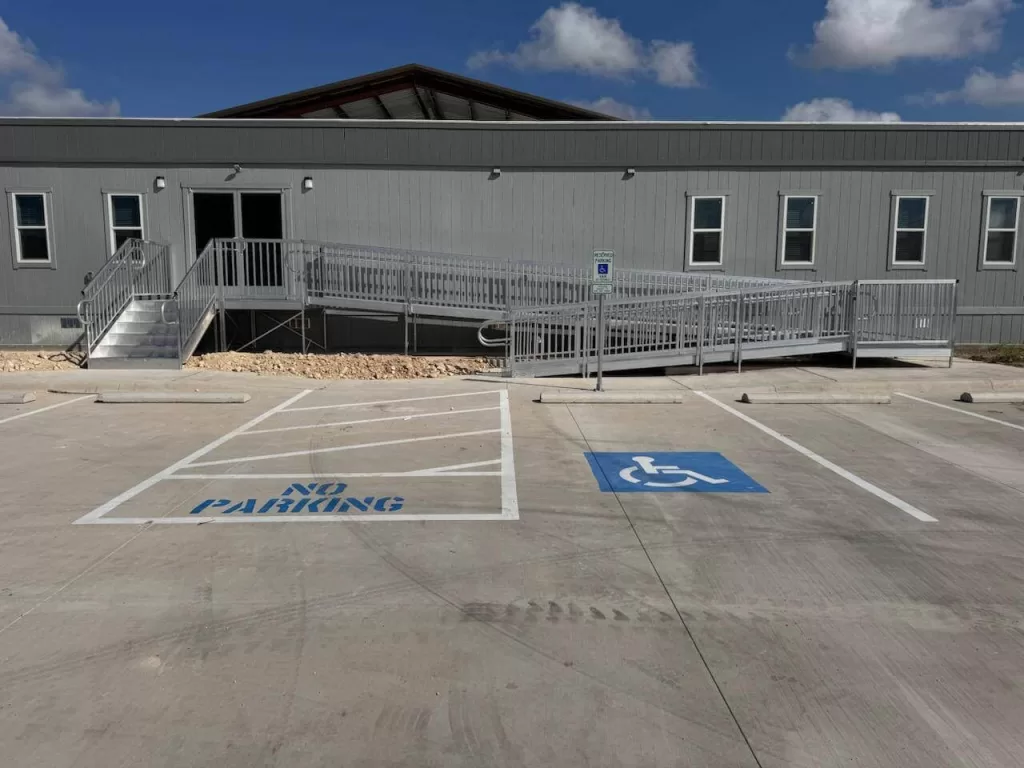
Nearly all public-facing US businesses are required to follow ADA ramp requirements for accessible design. While compliant handicap ramps and access points are a legal necessity, they’re also essential for creating an inclusive environment for everyone. In this article, we’ll look at common ADA mistakes and explain what you need to know to prevent violations and costly fines.
Some common violations business and restaurants make include:
- Incorrect ramp slope or incline (steeper than 1:12).
- No handrails on ramps with a rise over 6 inches.
- Narrow ramp width (must be at least 36 inches clear).
- Missing or uneven landings at the top/bottom.
- Surface hazards (cracked, slick, or uneven materials).
- Obstructions, such as trash bins, signage, or parked items blocking access.
What Triggers an ADA Compliance Audit or Inspection?
Most companies take accessibility seriously, but there are always less reputable businesses who try skirting the ADA standards. To counteract this, several parties can trigger or request a compliance audit or inspection. One such party is the US Department of Justice, which enforces the ADA at a federal level, but more commonly it’s triggered by local governments or building departments, private individuals or advocacy groups.
One helpful ramp inspection tip is to schedule a voluntary accessibility audit. This is sometimes called a self-evaluation or accessibility assessment, and can be done by hiring accessibility consultants or certified inspectors to identify and correct ADA violations before they become costly.
Remember: older buildings aren’t grandfathered in. They’re still expected to meet ADA requirements to the greatest extent possible.

What’s Included in an ADA Ramp Audit and Accessibility Inspection?
Depending on who initiated the audit, it can be carried out by different instances, such as DOJ investigators, Certified Accessibility Specialists (CASp), architect or engineers, private accessibility consultants, or local building inspectors.
These auditors review elements such as:
- Accessible entrances, ramps, and parking
- Interior routes, door widths, and thresholds
- Restroom layouts and fixtures
- Signage, lighting, and surface transitions
- Documentation or signage related to accessibility
How to Prevent ADA Fines and Avoid Lawsuits
The easiest way to stay ahead of any issues is scheduling regular ADA ramp maintenance and inspections, considering factors such as loose handrails, ramp damage, or slope changes. Choosing a durable, no-maintenance ramp, such as a commercial modular aluminum ramp will make your life easier – they’re easy to adjust and reconfigure for compliance.
Keep thorough documentation of any maintenance or remodels; photos and inspection notes not only show good-faith compliance, but also help you stay on track, and serve as a useful tool for contractors and accessibility inspectors. Detailed records can also demonstrate your commitment to ADA ramp compliance if ever questioned by inspectors or advocacy groups.
Last but not least, train your staff to keep ramps clear and safe at all times. Make sure they understand the importance of unobstructed access, routinely check that the ramp is free from debris or hazards, and report any wear or damage immediately. A well-informed team not only helps maintain ADA compliance, but also ensures a safe, welcoming environment for all customers, clients, and visitors.

Printable Quick ADA Ramp Checklist for Commercial Entrances
This quick ADA ramp compliance checklist is a great first step to help you verify that your business entrances meet federal and local accessibility requirements.
Download your ADA Ramp Compliance Checklist for Commercial Entrances
Not Sure if Your Ramp Meets ADA Standards?
Our experts can guide you in choosing the right ADA-compliant ramps, planning upgrades, and implementing modular solutions to keep your business compliant and accessible. With support from our extensive network of ADA-skilled contractors, we help ensure that every ramp installation meets ADA standards and passes inspection. Get in touch today to stay ahead of potential ADA violations and fines, and ensure safe, welcoming access for all visitors.
This content is provided for informational purposes only and should not be considered legal or regulatory advice. Please consult official government documents, local ordinances, and building codes to make sure you meet all applicable requirements.
Frequently Asked Questions
What are common ADA ramp violations?
Frequent issues include incorrect slope, missing handrails, uneven surfaces, and blocked access paths — all of which can lead to violations. Ramps narrower than 36 inches or steeper than a 1:12 slope are two of the most common infractions.
How can I prevent ADA fines?
Schedule regular ramp inspections, document maintenance, and use compliant materials or modular systems designed to meet ADA standards. Keep clear records of all ramp maintenance and inspections to demonstrate ADA compliance if audited.
What triggers a compliance audit?
Audits may follow a renovation, a customer complaint, or a routine accessibility review by local or federal agencies.
What is the penalty for ADA ramp violations?
Fines for ADA ramp violations can range from $75,000 for a first offense to $150,000 for repeat offenses under federal law. Local authorities may impose additional penalties or require immediate corrective action. Ensuring your ramps meet ADA compliance standards helps avoid costly fines and legal exposure.
Don’t Risk Injury To You Or A Loved One
Why wait? Give us a call at 877-596-7293 or contact us online to get started!

